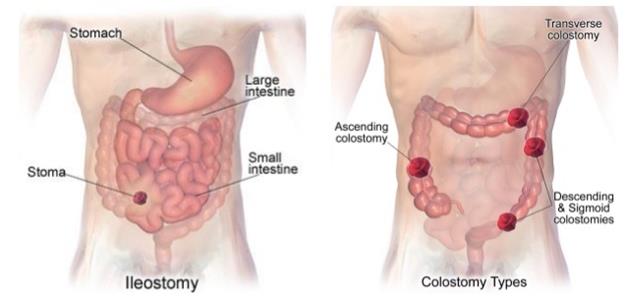Save 25% On Your First Autoship Order
Save 25% On Your First Autoship Order

Ostomy is a surgery which involves the creation of an opening or stoma in the abdominal wall to allow body wastes to be discharged. The body waste may be from the intestines or bladder. Depending on the reason for the surgery, this opening can be permanent or temporary and may be more than one. Temporary ostomy allows the organ to heal whereas permanent ostomy removes the organ altogether.Since the output from the opening cannot be controlled, an external collection pouch has to be attached to it via a skin barrier.
Ostomy is not a condition nor is it a disease. It is a surgical procedure.An internal injury may call for temporary rest to be given to the bowel or bladder. For another person the ostomy could be a permanent feature for any of the below reasons:
If the bowel or bladder has suffered injuries and is permanently damaged.
If there is a tumor which needs to be removed.
The digestive or urinary tract has a congenital or nerve defect.
As part of the treatment for Inflammatory Bowel Disease (IBD) such as Crohn’s Disease and ulcerative colitis.
The procedure involved could be colostomy, ileostomy or urostomy.
During colostomy, a part of the colon (or large intestine) is surgically removed and one end of the other part is diverted to a stoma in the abdominal wall to allow body wastes to pass out. A pouch is attached to the stoma for collection of feces. Once the pouch fills up, it has to be emptied out.
Colostomy can be temporary or permanent. In the temporary type, the procedure is carried out to allow the lower part of the colon to rest or heal. A permanent colostomy involves the loss of a part of the colon, usually the rectum.

There are different types of colostomies– ascending, descending, transverse and loop.
Ascending: It is performed on the ascending portion of the colon on the right side of the abdomen. This type is quite uncommon. The output is liquid to semi-liquid.
Descending: This is a common type and on the left upper abdomen. Output is semi-formed.
Sigmoid colostomy: This is again a common type which is performed on the sigmoid colon. It is on the lower left side of the abdomen.
Transverse or loop colostomy: Surgery involves the transverse colon and has one stoma with two openings, constructed as a loop. Output is liquid to semi-formed.
Ileostomy is similar to a colostomy but in this case, the diseased part of the ileum (or small intestine) has to be removed. The lower part is then diverted into an opening in the abdominal wall to form a stoma. Ileostomies may be temporary or permanent. It may involve removal of all or a part of the ileum.

There are two types of ileostomy – an end ileostomy and a loop/continent ileostomy.
End ileostomy: The colon and rectum are removed in this type of a surgery. The end part of the ileum is diverted into the abdominal wall to create a stoma opening.
Loop/continent ileostomy: This not a very common type. In this surgery, the colon and rectum are not removed but a pouch is created inside the abdomen using a part of the ileum. This pouch remains inside the body and a valve from the pouch connects to the stoma. An external draining pouch is not required in this case because the valve prevents the output from draining out. The stoma is cleaned using a catheter to flush out the fecal matter.
Urostomy refers to a surgical procedure which diverts urine away from a diseased or defective urinary bladder. It may include removal of the diseased bladder.A pouch is attached to the stoma opening to collect urine because the flow of urine, like feces, cannot be controlled.

There are two basic types of urostomies – ileal conduit (also referred to as standard/conventional) and continent urinary reservoir.
Ileal Conduit: Surgically, a small piece of the intestine is removed and its far end is connected to the abdominal wall to create a stoma. To the other end is attached the ureters which carry urine from the kidney to the bladder. This end is then sewn shut to be converted into a pouch to hold urine.The urine drains out through the stoma into an external pouch.
Continent urinary reservoir: In this type too, a pouch is created surgically inside the body to which the ureters are attached. The ureters carry the urine into the pouch where it is stored. But no stoma is created for urine drainage. Instead, a catheter is used to drain out the urine several times a day. Valves are constructed in the pouch to prevent reflux of urine into the kidneys.
There are several versions of the pouch in this type of a urostomy.
The Kock Pouch has pouch, valves and outlet made from terminal ileum.
The Indiana Pouch is made from the large intestine. Natural ileocecal valve is used for valve while the outlet is made from terminal ileum.
The Mitrofanoff Procedure has a pouch made from the bladder while outlet is made from the appendix. There are variations in this which include pouch made from large or small intestines or a combination of both. Outlet is made from the fallopian tube or ureter segment.
The Ileal Neobladder pouch is made from the small intestine while the outlet is the urethra. No stoma is required.
Living with ostomy will only be difficult if it is not managed well. If you have an ostomy bag attached, then taking care of yourself is of prime importance if you wish to live a normal life. The skin around the stoma has to be well looked after to ensure a quick recovery after surgery. A strict routine must be maintained to ensure cleaning of the stoma, managing hygiene of the pouch and changing the appliance whenever needed.The first few weeks after an ostomy can be distressing but quality of life need not suffer. Once the routine involving stoma care etc.sets in, things will again begin to look up. At this juncture, support from family and friends plays a crucial role.
Disclaimer: All content found on our website, including images, videos, infographics and text were created solely for informational purposes. Our content should never be used for the purpose of diagnosis or treatment of any medical conditions. Content shared on our websites is not meant to be used as a substitute for advice from a certified medical professional. Reliance on the information provided on our website as a basis for patient treatment is solely at your own risk. We urge all our customers to always consult a physician or a certified medical professional before trying or using a new medical product.

Ayush Henry, has been a Health Products For You contributor since 2016. He holds an MBA in hospitality and a MA in English. A professional HR soft skills trainer and copywriter, he ...
How To Increase Iron Levels Quickly
It’s a question that must have puzzled you like many others. Iron is essential in hemoglobin production and its inadequate levels can negatively impact your health. Dive into this informative article to explore top iron-rich foods that can help you fight iron deficiency.
10 Best Coccyx Cushions for Tailbone Pain
If you're like most people, you spend about 8 to 10 hours sitting every day. However unhealthy, it is part of life for many, and can cause tailbone pain. Coccyx cushions can help alleviate this pain. Click to read more and find the perfect coccyx cushion for your tailbone pain.
5+ Best Adult Diapers for Fecal Incontinence
Dealing with fecal incontinence can be challenging, but you're not alone. Read this article and navigate through discreet and effective solutions that help you manage fecal incontinence and let you live life on your terms with confidence and comfort.
Top 5 Best Reviewed Nebulizers of 2024
Need an effective and affordable nebulizer? Look no further, in this article we offer 5 of our best reviewed nebulizers that are loved by our customers. Click to read more and find the perfect nebulizer for all your respiratory needs.
10 Best Penis Pumps For Erectile Dysfunction
For anyone dealing with erectile dysfunction, penis pumps serve as a great way to manage it. But with so many products available, determining the best one for your needs can be challenging. To assist you in refining your choices and making an informed decision, here are our top 10 options, recognized for their effectiveness and safety.